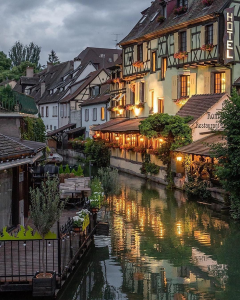Generally, an asset that is part of the setting is not a plant.
But, there have been a few instances in which assets that are a part of the setting but are not a part of the business premises have been determined to be a plant because they were also an apparatus that was used to carry out the business.
Jarrold (Inspector of Taxes)
v
John Good and Sons, Ltd
Court of Appeal
40 TC 681
7 December 1962
Jarrold v John Good & Sons Ltd carried on the business of shipping agents.
To satisfy its fluctuating accommodation requirements, the Company made use of special partitioning, which allowed it to subdivide the floor space available in any way that it chose.

The partitions were secured by screws to the structure of the building only at the floor and ceiling, and it was a relatively simple operation to move them from one position to another. It was common ground that the partitioning did not form part of the structure of the building.
On appeal against an assessment to Income Tax under Schedule D for the year 1960-61, the Company claimed that certain expenditure incurred in connection with the installation of the partitioning represented capital expenditure on the provision of plant, and therefore qualified for initial and annual allowances under Chapter II, Part X, Income Tax Act, 1952.
The Crown contended that the partitions were not a plant since they were merely the setting in which the Company’s business was carried on, that they were not apparatus used in carrying out the actual operations of the business and that they were not subject to wear and tear.
The General Commissioners decided that the partitioning was “plant” and that the Company was entitled to the allowances.
Held, that the Commissioners’ decision was correct, moveable partitions were held to be plant.

The partitions were essentially fixed but could be moved by the business during the course of the trade to expand offices or create new areas as required.
In actuality, the partitions were seldom moved.
Still, the Commissioners found that as a matter of commercial necessity, the partitions had to possess mobility and flexibility for the day-to-day running of the business.
The partitions were part of the setting but were not part of the premises in which the trade was carried on, They were apparatus with which the company carried on its business”.
The courts made an important distinction that apparatus such as movable partitions are not excluded from being a plant despite being part of the “setting”.
Another case where items which were part of the setting in which the trade was carried on were held to be a plant is the case of Leeds Permanent Building Society v Proctor (Inspector of Taxes) [1982]..
.
Demountable Screens, using similar tests as Jarrold v John Good, were also held as a plant in this case.
Leeds Permanent Building Society v Proctor
The John Good case does not mean that all moveable partitions are plant.
If you get a claim that moveable partitions are plant, you should check to see if they need to possess mobility as a matter of commercial necessity before you accept the claim. It is also worth checking whether they have, in fact, ever been moved.

In Leeds Permanent Building Society v Proctor, the society claimed that decorative screens used for window displays were plant.
The capital allowance claim was refused, and the society appealed.
The Inspector won at the Commissioners, so the society appealed to the High Court, where it won.
The Commissioners found that the purpose of the screens was to attract the attention of passersby and so bring business to society.
In the Commissioner’s view, the screens formed part of the “setting” of the business and did not perform any business function.

For the Crown, it was argued that the function of the screens to attract customers was insufficient to stamp them as a plant.
That had been the ship’s function in issue in Benson v. Yard Arm Club Ltd. and it was held in that case that the ship was not a plant of the restaurant business.
It was further argued for the Crown that items used to make the setting of a business more attractive do not satisfy the functional test to qualify as plant unless the provision of an attractive setting is itself found to be part of the trade processes or the item or form of the attraction is dictated by the nature of the trade processes.
That argument was based on a principle drawn by reconciling several authorities on the meaning of the word “plant”.

The High Court held that the window screens were part of the shop furniture with which the trade of the society was carried on in the branch office concerned.
The screens in question were of a decorative nature, and all contained the Society’s name in a prominent position.
The screens were not capable of use without considerable modification for any business but that of the Leeds Permanent Building Society, and indeed some were of such a character that they were really only of use in the particular branch.
Each was readily removable, and they were never left at a branch office which was vacated by the Society.
It was argued for the Society that they performed a business function, namely attracting custom to the branch offices. In this, it was submitted, they were indistinguishable from the fascia boards and projecting signs used to proclaim the identity of the Society’s offices. Those signs had been treated as “plant” by the Commissioners.

Held, appeal allowed.
The determination of the Commissioners was not consistent with the facts they found.
There is nothing in those facts which shows that the screens were part of the setting. Nor were they part of or inseparably annexed to the structure of the branch.
On the facts found, the screens were part of the furniture with which the Society trade was carried on in a branch office.
They served to attract the public’s attention to bring business to Society. Accordingly, the Commissioners erred in law.
Unlike the ship, in Benson’s case, the screens, in this case, were an adjunct to the carrying on of the business rather than the premises of the business.
What this Means
Hence, the determination of what would constitute a ‘plant’ or ‘setting’ would very much depend on the nature of taxpayer’s business.
the Decided cases, such as the movable partitions in the John Good case, the window screens in the Leeds Permanent case and decor items in the Scottish and Newcastle case, illustrated that an item, which could be properly described as being part of the setting, could also be plant depending on the functions performed by the items in question and the nature of taxpayers’ business.

Our website's articles, templates, and material are solely for reference. Although we make every effort to keep the information up to date and accurate, we make no representations or warranties of any kind, either express or implied, regarding the website or the information, articles, templates, or related graphics that are contained on the website in terms of its completeness, accuracy, reliability, suitability, or availability. Therefore, any reliance on such information is strictly at your own risk.
Keep in touch with us so that you can receive timely updates |
要获得即时更新,请与我们保持联系
1. Website ✍️ https://www.ccs-co.com/ 2. Telegram ✍️ http://bit.ly/YourAuditor 3. Facebook ✍
- https://www.facebook.com/YourHRAdvisory/?ref=pages_you_manage
- https://www.facebook.com/YourAuditor/?ref=pages_you_manage
4. Blog ✍ https://lnkd.in/e-Pu8_G 5. Google ✍ https://lnkd.in/ehZE6mxy
6. LinkedIn ✍ https://www.linkedin.com/company/74734209/admin/






